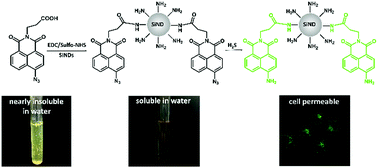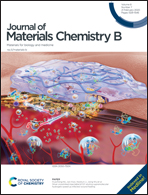A new strategy to improve the water solubility of an organic fluorescent probe using silicon nanodots and fabricate two-photon SiND-ANPA-N3 for visualizing hydrogen sulfide in living cells and onion tissues†
Abstract
A small-molecule fluorescent probe offers unique advantages for the detection of hydrogen sulfide (H2S) and other reactive small molecules including high sensitivity, cell permeability and high spatiotemporal resolution. Generally, in order to obtain good cell permeability, fluorescent probes are liposoluble, which in turn leads to poor water solubility. Thus, it is regrettable that most of these fluorescent probes cannot be used in fully aqueous systems and hence, organic solvents are used, which may cause negative effects on living cells. Silicon nanodots (SiNDs) have been widely used in many fields due to good water solubility, benign nature, biocompatibility and low toxicity. Herein, we proposed a two-photon SiND-ANPA-N3 fluorescent probe with good water solubility, excellent biocompatibility and low toxicity; it is suitable to detect H2S in totally aqueous media and living cells. This strategy may provide a technically simple and facile approach for designing fluorescent probes with excellent solubility, benign nature, and biocompatibility for use in fully aqueous systems and in vivo.



 Please wait while we load your content...
Please wait while we load your content...